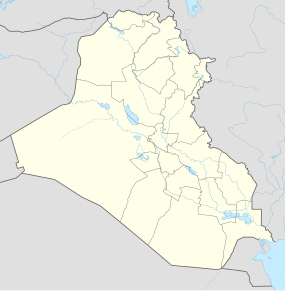Dur-Sharrukin
| ܕܘܪ ܫܪܘ ܘܟܢ (Syriac) دور شروكين (Arabic) |
|

A human-headed winged bull known as a lamassu from Dur-Sharrukin. Neo-Assyrian Period, ca. 721–705 BC
|
|
| Alternate name | Khorsabad |
|---|---|
| Location | Khorsabad, Nineveh Province, Iraq |
| Region | Mesopotamia |
| Coordinates | 36°30′34″N 43°13′46″E / 36.50944°N 43.22944°ECoordinates: 36°30′34″N 43°13′46″E / 36.50944°N 43.22944°E |
| Type | Settlement |
| Length | 1,760 m (5,770 ft) |
| Width | 1,635 m (5,364 ft) |
| Area | 2.88 km2 (1.11 sq mi) |
| History | |
| Founded | In the decade preceding 706 BC |
| Abandoned | Approximately 605 BC |
| Periods | Neo-Assyrian Empire |
| Cultures | Assyrian |
| Site notes | |
| Excavation dates | 1842–1844, 1852–1855 1928–1935, 1957 |
| Archaeologists | Paul-Émile Botta, Eugène Flandin, Victor Place, Edward Chiera, Gordon Loud, Hamilton Darby, Fuad Safar |
| Condition | Destroyed/irreparably damaged |
| Public access | Inaccessible |
Dur-Sharrukin ("Fortress of Sargon"; Arabic: دور شروكين), present day Khorsabad, was the Assyrian capital in the time of Sargon II of Assyria. Khorsabad is a village in northern Iraq, 15 km northeast of Mosul. The great city was entirely built in the decade preceding 706 BC. After the unexpected death of Sargon in battle, the capital was shifted 20 km south to Nineveh.
Sargon II ruled from 722 to 705 BC. In 717, Sargon ordered the construction of a new palace-city at the confluence of the Tigris and the Greater Zab rivers. The demands for timber and other materials and craftsmen, who came from as far as coastal Phoenicia, are documented in contemporary Assyrian letters. The debts of construction workers were nullified in order to attract a sufficient labour force. The land in the environs of the town was taken under cultivation, and olive groves were planted to increase Assyria's deficient oil-production. The great city was entirely built in the decade preceding 706 BC, when the court moved to Dur-Sharrukin, although it was not completely finished yet. Sargon was killed during a battle in 705. After his unexpected death his son and successor Sennacherib abandoned the project, and relocated the capital with its administration to the city of Nineveh, 20 km south. The city was never completed and it was finally abandoned a century later when the Assyrian empire fell.
On 8 March 2015 the Islamic State of Iraq and the Levant reportedly started the plunder and demolition of Dur-Sharrukin, according to the Kurdish official from Mosul Saeed Mamuzini. The Iraqi Tourism and Antiquities Ministry launched the related investigation on the same day.
The town was of rectangular layout and measured 1758.6 by 1635 metres. The enclosed area comprised 3 square kilometres, or 288 hectares. The length of the walls was 16280 Assyrian units, which according to Sargon himself corresponded to the numerical value of his name. The city walls were massive and 157 towers protected its sides. Seven gates entered the city from all directions. A walled terrace contained temples and the royal palace. The main temples were dedicated to the gods Nabu, Shamash and Sin, while Adad, Ningal and Ninurta had smaller shrines. A temple tower, ziqqurat, was also constructed. The palace was adorned with sculptures and wall reliefs, and the gates were flanked with winged-bull shedu statues weighing up to 40 tons. Sargon supposedly lost at least one of these winged bulls in the river.
...
Wikipedia

